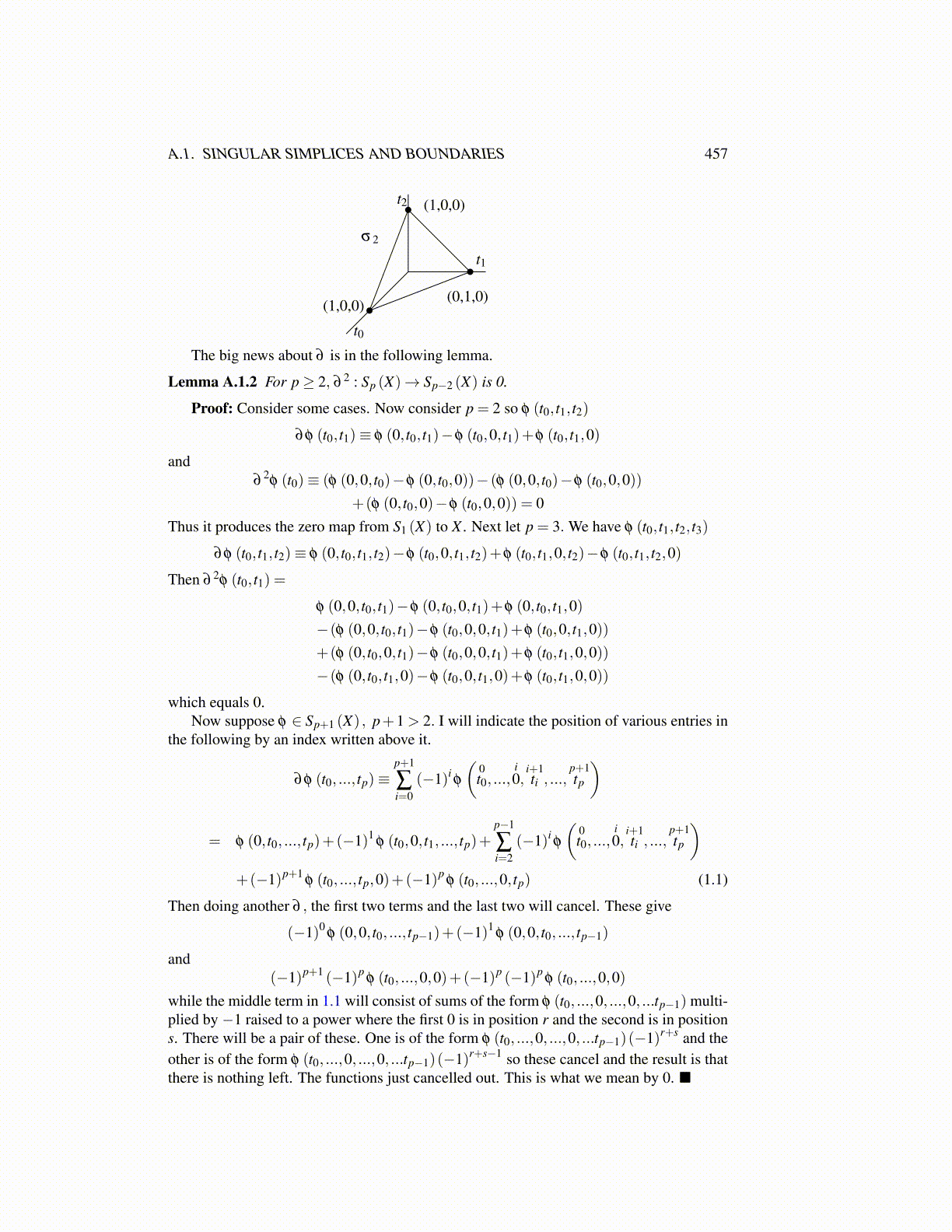
A.1. SINGULAR SIMPLICES AND BOUNDARIES 457
(0,1,0)(1,0,0)
(1,0,0)
σ2
t0
t2
t1
The big news about ∂ is in the following lemma.
Lemma A.1.2 For p≥ 2, ∂ 2 : Sp (X)→ Sp−2 (X) is 0.
Proof: Consider some cases. Now consider p = 2 so φ (t0, t1, t2)
∂φ (t0, t1)≡ φ (0, t0, t1)−φ (t0,0, t1)+φ (t0, t1,0)
and∂
2φ (t0)≡ (φ (0,0, t0)−φ (0, t0,0))− (φ (0,0, t0)−φ (t0,0,0))
+(φ (0, t0,0)−φ (t0,0,0)) = 0Thus it produces the zero map from S1 (X) to X . Next let p = 3. We have φ (t0, t1, t2, t3)
∂φ (t0, t1, t2)≡ φ (0, t0, t1, t2)−φ (t0,0, t1, t2)+φ (t0, t1,0, t2)−φ (t0, t1, t2,0)
Then ∂ 2φ (t0, t1) =
φ (0,0, t0, t1)−φ (0, t0,0, t1)+φ (0, t0, t1,0)−(φ (0,0, t0, t1)−φ (t0,0,0, t1)+φ (t0,0, t1,0))+(φ (0, t0,0, t1)−φ (t0,0,0, t1)+φ (t0, t1,0,0))−(φ (0, t0, t1,0)−φ (t0,0, t1,0)+φ (t0, t1,0,0))
which equals 0.Now suppose φ ∈ Sp+1 (X) , p+1 > 2. I will indicate the position of various entries in
the following by an index written above it.
∂φ (t0, ..., tp)≡p+1
∑i=0
(−1)iφ
(0t0, ...,
i0,
i+1ti , ...,
p+1tp
)
= φ (0, t0, ..., tp)+(−1)1φ (t0,0, t1, ..., tp)+
p−1
∑i=2
(−1)iφ
(0t0, ...,
i0,
i+1ti , ...,
p+1tp
)+(−1)p+1
φ (t0, ..., tp,0)+(−1)pφ (t0, ...,0, tp) (1.1)
Then doing another ∂ , the first two terms and the last two will cancel. These give
(−1)0φ (0,0, t0, ..., tp−1)+(−1)1
φ (0,0, t0, ..., tp−1)
and(−1)p+1 (−1)p
φ (t0, ...,0,0)+(−1)p (−1)pφ (t0, ...,0,0)
while the middle term in 1.1 will consist of sums of the form φ (t0, ...,0, ...,0, ...tp−1) multi-plied by −1 raised to a power where the first 0 is in position r and the second is in positions. There will be a pair of these. One is of the form φ (t0, ...,0, ...,0, ...tp−1)(−1)r+s and theother is of the form φ (t0, ...,0, ...,0, ...tp−1)(−1)r+s−1 so these cancel and the result is thatthere is nothing left. The functions just cancelled out. This is what we mean by 0. ■